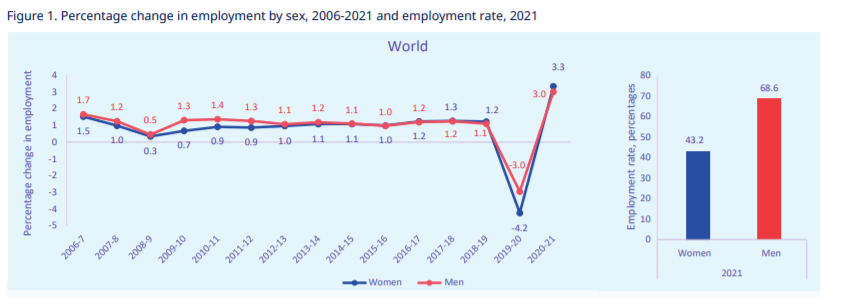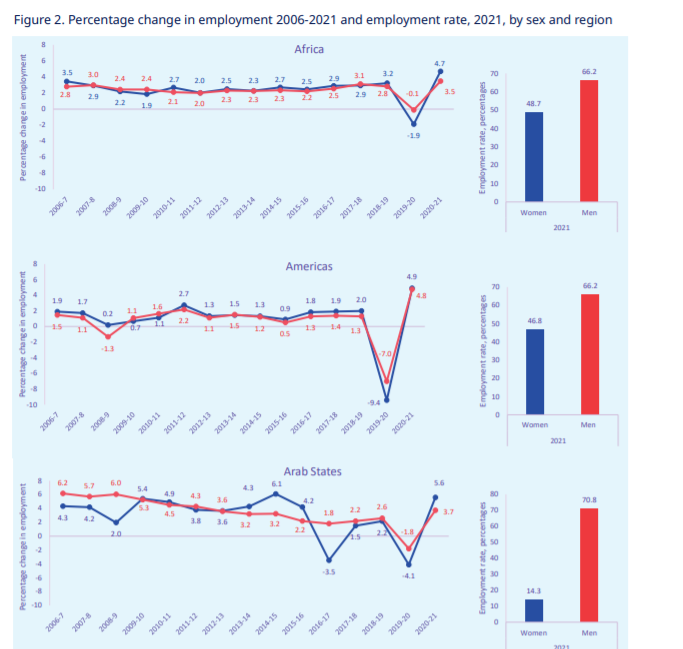Despite the recovery from the pandemic, there will be fewer women in employment than men, while persisting into the near future, according to the International Labour Organization (ILO).
The report highlights that there will be 13 million fewer women in employment in 2021 compared to 2019 levels, while employment of men recover to 2019 levels. Although it is evident that projected job growth for women in 2021 is well above that of men, it will not be enough to assume pre-pandemic employment levels.
Therefore, the report calls for the need to place gender equality at the core of the recovery effort and set gender-responsive mechanisms.
These efforts include channeling investments into the care economy because the health, social work and education sectors are major employment generators, especially for women. This action acknowledges that care leave policies and flexible working arrangements can encourage a more even division of work at home between men and women.
Furthermore, the report recommends for work towards universal access to comprehensive, adequate and sustainable social protection for all. This is to help reduce the current gender gap in social protection coverage.
Also, it encourages the need for equal pay regarding work of equal value, while also eliminating violence and harassment in the world of work. Again, it promotes the participation of women in decision-making bodies, social dialogue and social partner issues.

According to the report, only 43.2 per cent of the world’s working-age women will be employed in 2021, compared to 68.6 per cent of working age men. This mirroring effect is foreshadowed by women’s overrepresentation in the hardest-hit sectors as at 2020 such as accommodation and food services, and the manufacturing sector.
Disparities in the pandemic’s effect on employment across countries
Between 2019 and 2020, employment of women declined by 4.2 per cent, representing a drop of 54 million jobs, while men’s employment declined by 3 per cent, representing 60 million jobs.
This notwithstanding, there is disparity in this particular effect of the pandemic across regions all over the world. The Americas experienced the greatest reduction in women’s employment as a result of the pandemic (a reduction of 9.4 per cent). The second highest drop in the number of employed women was observed in the Arab States, representing decline in women’s employment by 4.1 per cent and men’s employment by 1.8 per cent.
Furthermore, in Asia and the Pacific, the COVID-19 pandemic led women’s employment to decrease by 3.8 per cent, compared to a decline of 2.9 per cent for men. In Europe and Central Asia, women’s employment was truncated considerably more than men’s, leading to a 2.5 per cent and a 1.9 per cent decrease, respectively.
In Africa, men’s employment experienced the smallest decline across all the regions, with just a 0.1 per cent drop between 2019 and 2020, while women’s employment decreased by 1.9 per cent.

Nonetheless, the situation was more favourable in Chile and Colombia where wage subsidies were applied to new hires with higher subsidy rates for women.
More so, Colombia and Senegal were among countries who created or strengthened support for women entrepreneurs. In other places, such as Mexico or Kenya, quotas were established to guarantee that women benefited from public employment programmes.
READ ALSO: Popo-Cee-Popo Global provides step-by-step guide to Mini Trommel and ANT Concentrator use




















